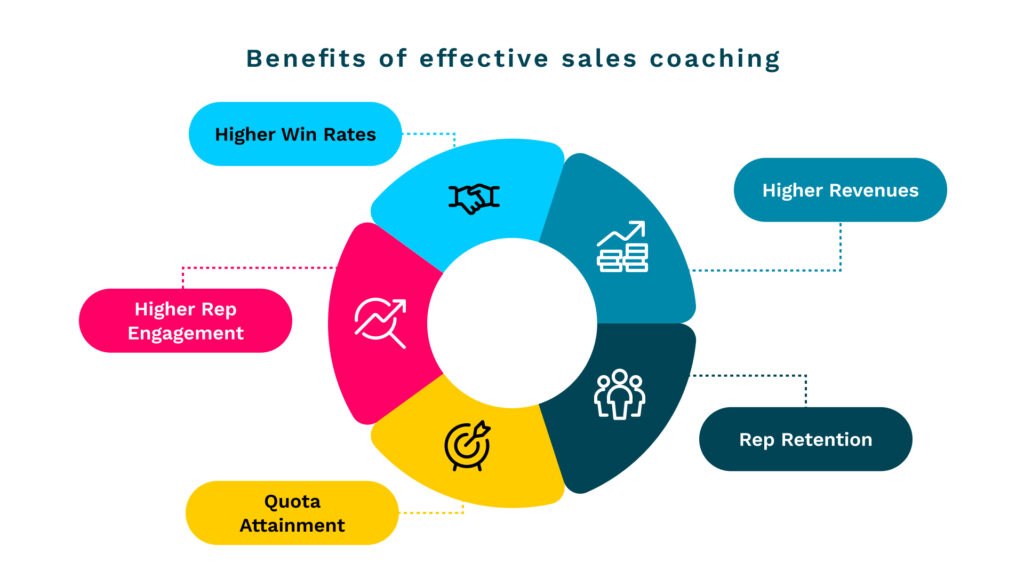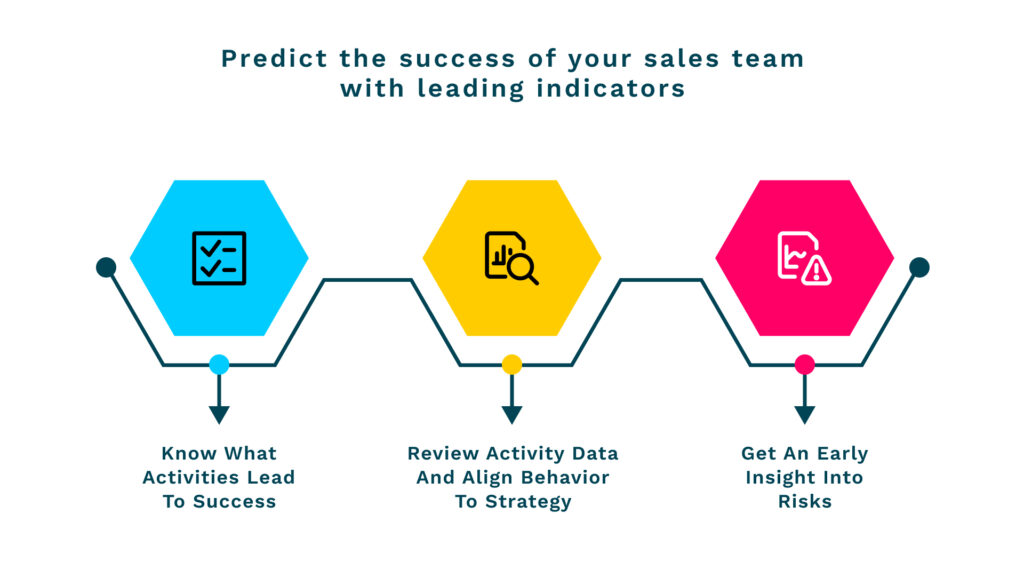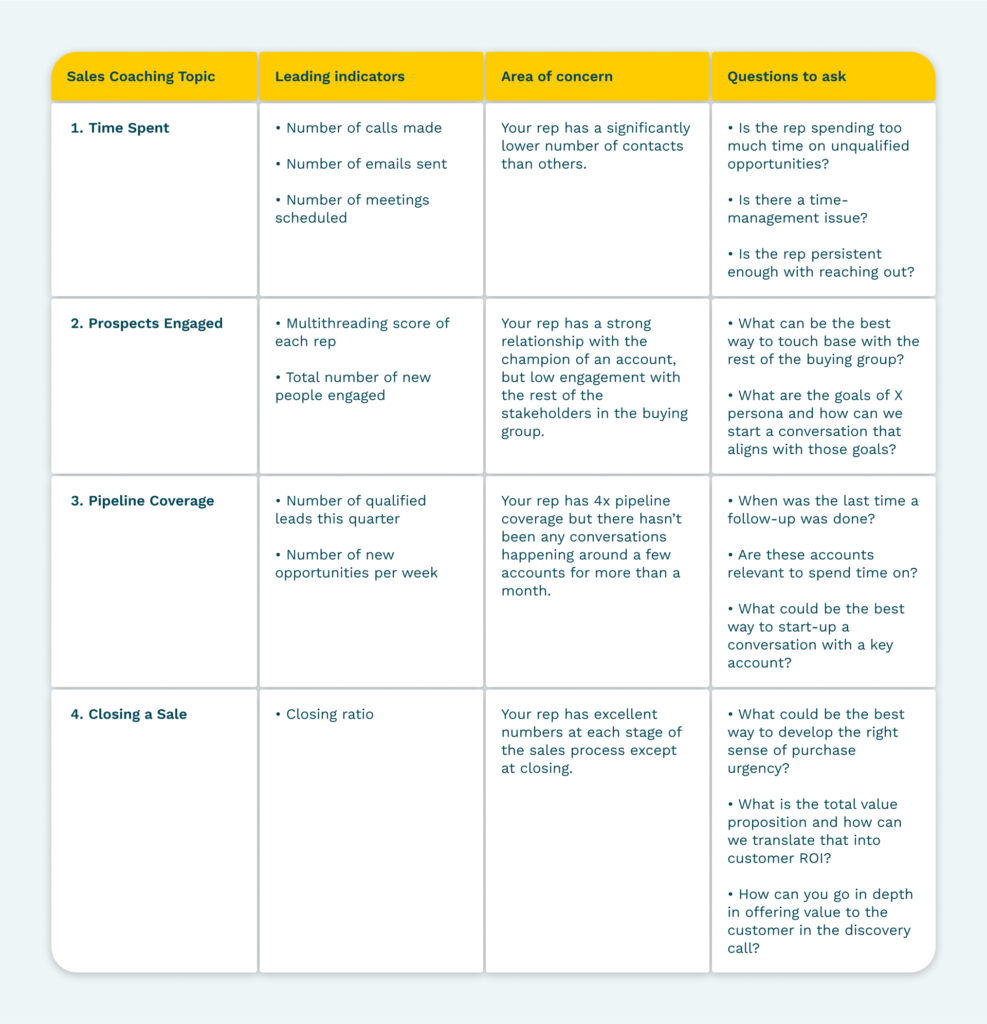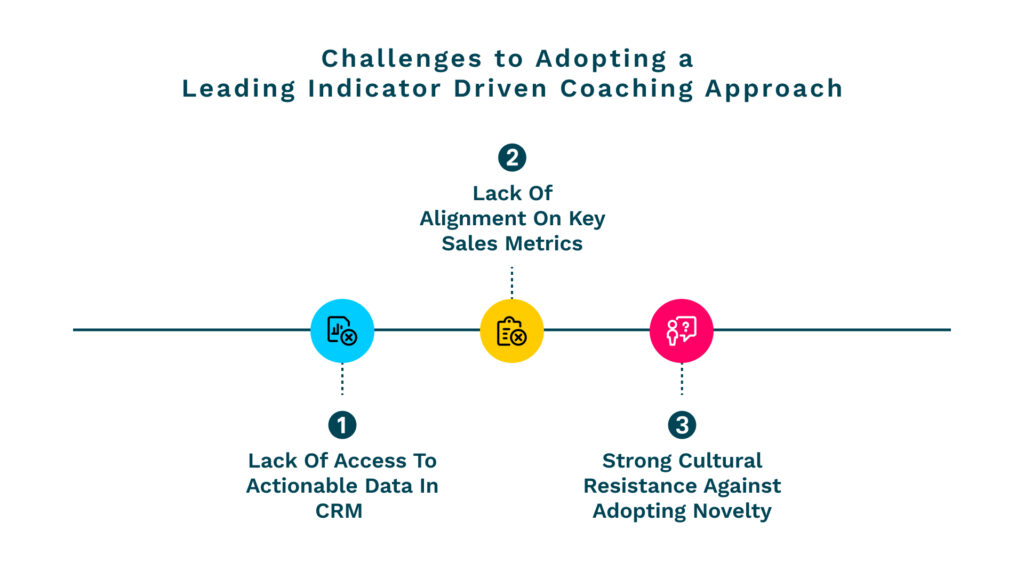Your sales process is like a road. Driving on this road is never going to be a linear journey from one point to another. Like any sales process, you can expect a bumpy ride with several roadblocks on the way to the ultimate destination.
It’s not enough to just look at the rearview mirror and see how far you’ve come. It’s equally important to look through the windshield towards the road ahead, with a far enough view to know where to pivot, stop or take a detour.
Similarly, to smoothly transition from one stage to another within your sales process and reach the ultimate stage of closing a deal, you need to look not just at your past learnings and outcomes, but also have a clear view of how to get to your destination.
This is possible through technology that helps you see what lies ahead, and recommends what you can do today to avoid any obstruction in the future.
By knowing what needs to change today for a better tomorrow, sales managers can coach their reps on where to pivot the car to avoid any possible challenges that lie ahead. To do this effectively, sales managers need access to data that helps them predict future outcomes.
With leading indicators (through the windshield), managers can identify rep behaviors in real time, and get alerted on what changes need to be made now to avoid complications in the future.

Sales Coaching Needs a Change of Gear
There is enough evidence to prove the positive impact of effective sales coaching on business outcomes and rep productivity.
Effective sales coaching leads to:
1. Higher win rates
Companies with dynamic sales coaching programs achieve 28% higher win rates.
2. Higher revenues
Companies that provide quality coaching can reach 7% annual revenue growth.
3. Rep retention
60% of sales reps say they are more likely to leave their job if their manager is a poor coach.
4. Quota attainment
And when coaching skills exceed expectations, 94.8% of reps meet quota.
5. Higher rep engagement
Employees who report to managers who coach effectively are 40% more engaged.

The benefits of sales coaching are clearly very encouraging.
But here’s the bad news.
Most sales managers fail to prioritize sales coaching as a key strategy to make reps more productive. And for those who do, they don’t do it right.
Sales has changed a lot in the last few years. Buyers are more intelligent than ever and remote work has forced sales teams to adapt to a challenging environment.
But coaching has failed to evolve with these changes, with managers still using past outcomes as metrics for coaching.
Most managers do not have the right knowledge, tools or strategies to coach their reps the right way.
The result? Same old deal reviews that are more of status updates than inspiring sessions.
And before companies realize, bad coaching whirlwinds into high rep turnover, failure to meet quota, unhappy reps and lower profits.
Sales coaching needs a gear change, with a serious focus on how organizations look at metrics to measure performance of sales reps.
Making a Case for Leading Indicators in Sales Coaching
Sales coaching strategies have been traditionally defined on the basis of metrics that highlight past outcomes. These metrics are called lagging indicators.
Some examples of lagging indicators could be:
- Annual Revenue
- Quota Attainment
- Sales Cycle Length
- Average Deal Length
- Win Rate
Lagging indicators are important to evaluate performance. But measuring just them is not enough as they fail to give a view of what the future might hold.
Instead, sales managers should measure the right behaviors to enable their reps to do the right things to be successful.
In short, managers need to focus on leading indicators.
Leading indicators are metrics that can be used as predictive measures of future performance. They are based around early activities that translate into pipeline generation and conversion, and not just results.
For example, with leading indicators, your sales managers can precisely know the activities that your best rep indulges in to close deals. Or figure out the behaviors of a rep who is stuck at the closing stage.
By accessing these business activities being translated into behavior data, your sales managers can figure out the gaps and coach reps on the basis of that data.
These leading indicators give sales managers early insights into opportunities and potential risks that lie ahead, with enough scope to course correct before time runs out.
By depending on leading indicators, managers can know well ahead of time what needs to be done to change behaviors of reps, and turn coaching sessions into proactive discussions rather than reactive meetings.
This way, leading indicators help you see much further down the road for you to predict whether you’ll hit or miss your targets. And if the prediction hints towards an accident ahead, managers can course correct way before the incident takes place.
Hence, using leading indicators as a coaching tool for sales managers allows you to:
1. Have a clear view of what activities lead to success
Your sales reps and managers can know exactly what activities can drive them towards success through real-time data.
2. Review activity data and align behavior to strategy
You can use activity data to measure if your team is making the right behavior switch at the right time to reach goals.
3. Get an early insight into risks
Leading indicators can help view potential risks that may affect future performance. Managers can rectify it in real time much before the damage happens through the right coaching.

Examples of How Leading Indicators Can Amplify the Impact of Sales Coaching
Let’s look at some examples of leading indicators according to certain areas and how they can amplify the impact of sales coaching on rep productivity.
1. Time Spent
When sales managers know which activities reps are spending their time on, they can align coaching sessions to improve any inefficiencies that they see in the process being followed.
Here, the leading indicators could be:
- Number of calls made
- Number of emails sent
- Number of meetings scheduled
Example - Your rep has a significantly lower number of contacts than others. Questions to ask:
- Is the rep spending too much time on unqualified opportunities?
- Is there a time-management issue?
- Is the rep persistent enough with reaching out?
2. Prospects Engaged
The buying committee has significantly increased, with an average of 6.8 decision makers in every B2B purchase. Sales managers should know if reps are successfully engaging all stakeholders of this buying committee.
Here, the leading indicators could be:
- Multithreading score of each rep
- Total number of new people engaged
Example - Your rep has a strong relationship with the champion of an account, but low engagement with the rest of the stakeholders in the buying group.Questions to ask:
- What can be the best way to touch base with the rest of the buying group?
- What are the goals of X persona and how can we start a conversation that aligns with those goals?
3. Pipeline Coverage
By having visibility into the pipeline coverage of each rep, sales managers can know if the important accounts are being targeted in the right ways.
Here, the leading indicators could be:
- Number of qualified leads this quarter
- Number of new opportunities per week
Example - Your rep has 4x pipeline coverage but there hasn’t been any conversations happening around a few accounts for more than a month.Questions to ask:
- When was the last time a follow-up was done?
- Are these accounts relevant to spend time on?
- What could be the best way to start-up a conversation with a key account?
4. Closing a Sale
Sales managers need to be at the top of the closing stage for their reps to ensure there are no bottlenecks.
Here, the leading indicator could be:
- Closing ratio
Example - Your rep has excellent numbers at each stage of the sales process except at closing. Questions to ask:
- What could be the best way to develop the right sense of purchase urgency?
- What is the total value proposition and how can we translate that into customer ROI?
- How can you go in depth in offering value to the customer in the discovery call?

Challenges to Adopting a Leading Indicator Driven Coaching Approach
If the scope of using leading indicators in driving sales coaching strategies has so many advantages, why are organizations still struggling to use it as a way to boost and measure rep productivity?
Let’s look at some of the key reasons why:
1. Lack of access to actionable data in CRM
Access to actionable data is crucial to complete numerous sales tasks. Your reps and managers need easy access to buyer data at all times.
But most CRM systems are not set up to provide direct access to records without jumping through hoops. Data is lost in huge databases which do not allow sales teams to quickly locate specific sets of records to finish a task.
Not only this, 91% of data in CRM systems is predicted to be incomplete, stale, or duplicated each year. These CRM related challenges hamper productivity of sales reps, take them off the “selling floor” by forcing them to manually punch in numbers and waste valuable time that could have otherwise been spent on selling.
And even if sales managers get to work around data, there is a doubt of how accurate it really is. So sales managers do not know what data they should look at so that they can use those insights to drive up the benefits of their coaching efforts.
2. Lack of alignment on key sales metrics
To make the sales process frictionless, it’s crucial for different functions in your organization to be aligned to the same goals. And to achieve this goal, the sales metrics also have to be similar.
Working in silos and measuring different metrics for each department paves way for siloed efforts that don’t generate results. Most organizations go after their own individual metrics that often don’t overlap with other functions. This lack of alignment makes it difficult to work towards goals cross-functionally.
Even if businesses aim to achieve this alignment through data, CRM does not capture enough data to be effectively leveraged across the entire organization. 52% of businesses say that their CRM isn’t functioning well, with the biggest complaint being the inability to access aggregated data across multiple platforms.
For instance, CRM does not allow sales managers to identify and predict which customer needs a follow-up. If they had access to that information, they could have taken the right step and probably saved the company from losing that customer.
3. Strong cultural resistance against adopting novelty
Making a case for shifting from leading to lagging indicators requires not just a technology change. It requires a change of mindset that needs to trickle down from the leadership to the frontline.
Achieving this cultural change is challenging and there can be a lot of resistance to new ideas. Moving from traditional approaches to new ways of working can raise questions around trust, transparency and outcomes.
For management, the reasons for resistance to change could be because of complexity, lack of training, loss of power and influence or short term profit loss. For employees, resistance could come from confused work roles, unwillingness to learn, fear of not being able to perform with the new system etc.
All the stakeholders involved in a process change need to see the value that a focus on leading indicators can bring. For leadership, it is showing proof that by having real visibility into what’s worked in the past and for sales reps it’s the conviction that they can now do their jobs better.
Without beginning in this cultural change, businesses will continue to focus on the wrong metrics that lay the foundation of their sales coaching strategies.

How to Define Your Own Leading Indicators
There is no one-size-fits-all set of leading indicators that can be applied to any coaching set up.
Every business needs to take out the time to lay down their own leading indicators on the basis of their business goals and sales process.
Here are some key steps to help you find your leading indicators:
1. Define your strategic objectives
Identify your business strategy and define what it is that you want to achieve. This can be outcome goals around financial performance such as increased profits, higher customer satisfaction or increased market share.
Your ultimate goal is to get as many salespeople to hit quota as possible—your leading indicator there is whether you have enough pipeline, and your leading indicator to that is activity.”
2. Define success metrics for your objectives
Once the strategic objectives are defined, think about what success of each objective should look like.
This means defining your outcome or lagging indicators to achieve your objectives, such as quota attainment.
3. Identify activities that will lead to success
Try to figure out what activities you need to perform to meet your goals. Dig deeper and ask questions that can help develop an in-depth analysis of what needs to be done.
4. Define your leading indicators
This is the final step where you need to define your leading indicators that can help you measure the activities you listed out in step 3. These are setting measures of activities you need to perform to achieve your lagging indicators, and tracking them over time to identify signals.
Enable Managers to Coach With Leading Indicators with Nektar
Nektar’s platform provides AI-powered recommendations through leading indicators to help sales managers stay on top of rep performance and improve the coaching experience.
Our solution translates rep business activity into behavior data by automatically capturing it from internal systems like Zoom, email and calendars and sets it up for internal review. This gives your sales team unprecedented visibility into team performance and a full picture of identifying which reps need coaching and on what areas.
With our unified view of the entire sales process,
- Managers can be better coaches with access to leading indicators
- Reps can develop data driven sales skills to perform at their best capacity
- Companies can grow revenue in a predictable way by knowing when to pivot
Change your focus to leading indicators when it comes to sales coaching. Book a demo with us to help you maximize the impact of your sales coaching strategy.







